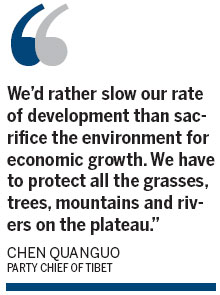No more delays
"The situation is too serious to allow further delays," said Shen Xiaoyue, director of the Policy Research Center for Environment and Economy at the Ministry of Environmental Protection. "After 30 years of fast-track economic development since the 1980s, the environmental damage that's resulted from the GDP-centered policy has become all too apparent.
"The public is understandably alarmed by the heavy smog, which on bad days seems to engulf entire regions of the country, and judging by all the evidence, if not handled properly and directly, environmental issues have the potential to not only erode government credibility, but also to threaten social stability," said Shen, referring to the abandonment of plans to construct a number of chemical works in the light of widespread public protests.

But no amount of genuine concern on the part of the decision-makers can ensure a quick turnaround, she said. "It's simply not feasible to put a sudden brake on all economic activities deemed environmentally unfriendly. Let's face it: while we are trying to pay our dues for the less-than-sensitive development in the past, new environmental debts are bound to be generated by ongoing activities. But that does not render our efforts meaningless because we will eventually owe less and less to nature," she said.
"The immense size of the country and the severity of the issue make the task China faces in developing and reconciling nature a unique enterprise. While we can learn from the experiences of others, we also have to be very inventive and practical to solve so many problems."
The environmental damage caused by economic development in the relatively developed coastal areas of East China has provided many lessons for the authorities in the Tibet autonomous region. The region's GDP was 80.2 billion yuan ($13.2 billion) in 2013, and the local government invested 4.82 billion yuan in improving the environment, according to the government. Last year, trees were planted in an area covering more than 1 million mu (66,667 hectares).
"We'd rather slow our rate of development than sacrifice the environment for economic growth. We have to protect all the grasses, trees, mountains and rivers on the plateau," said Chen Quanguo, the Party chief of Tibet.
The two sessions in Tibet concluded in Lhasa on Jan 14. Danzen, chairman of the CPPCC of Medog county, submitted two proposals concerning the development of the Chinese "Arcadia", focusing on the development of an ecological economy.
"After conducting an investigation, experts and scholars from the east of the country concluded that the only way to improve the standard of living in Tibet was to develop an ecological economy," Danzen said.
So far, more than 7,000 mu of land have been used to grow organic teas high in the mountains, utilizing the unpolluted soil and water and atmospheric conditions that are suitable for the cash crop. The area under cultivation will be expanded to more than 10,000 mu in 2015 and 20,000 mu in 2020.
"Natural resources and the environment are the most important things for us. We can't sacrifice the environment for economic development. We cannot take the old wrong road," Danzen said.
Indispensable role
The Inner Mongolia autonomous region, known for its stunning, rolling grasslands, also has an indispensable role to play in the environmental protection program.
"The formation of ethnic cultures relies on the natural environments in which the people live. Environmental change will lead to changes in lifestyle, so the preservation of a good natural environment is paramount to maintaining traditional cultures and is the basis of nurturing a healthy cultural industry," said political adviser Chen Shengli, who also heads an urban construction company in Hohhot, the capital of Inner Mongolia.
Further west, Yinam Nasardin, director of the tourism department of the Xinjiang Uygur autonomous region and a CPPCC deputy, said the region has benefited from the "Beautiful China" program, which is bringing more visitors to the region and boosting local tourism.
"We simultaneously develop and protect our tourism resources, but protection is our top priority," said Nasardin. "Thanks to the beautiful landscape of Xinjiang, we have seen an increasing number of visitors from all over the world. The number of foreign visitors rose to 1.5 million last year from 500,000 in 2012."
Degree of development
Cai Shangwei, director of the Culture Industry Research Center at Sichuan University, has first-hand knowledge of the complexities the authorities face.
In the summer of 2012, Cai and a number of like-minded academics launched the "Beautiful China" research project nearly six months before the concept first appeared in policy papers during the first plenary session of the 18th CPC Central Committee, convened in November of that year.
"We basically used a number of indexes to calculate specific cities' 'degree of development' in five areas - environmental protection, the local economy, and cultural, political and social life. Of the 100 possible points on offer, the environment could be marked from 0 to 28, while the four other categories were marked from 0 to 18. We publish the rankings annually, based on the number of points that each city has accrued," he said. "The purpose of this system is to find a way to cohesively weave ecological factors into the assessment of the general level of well being."
The indexes employed by Cai and his team have been adjusted since "beautiful China" acquired its current status, with some added and some discarded. All the statistics are provided by the central and local governments.
"Until now, they've been extremely helpful," said Cai. "It may sound ambitious, but what we set out to do is not only to inform the government with our research, but to work closely with it to design policy and solve problems."
Zhao Xu, Yang Yang and Peng Yining contributed to this story.
|
|
|
|
|
|
|
|
